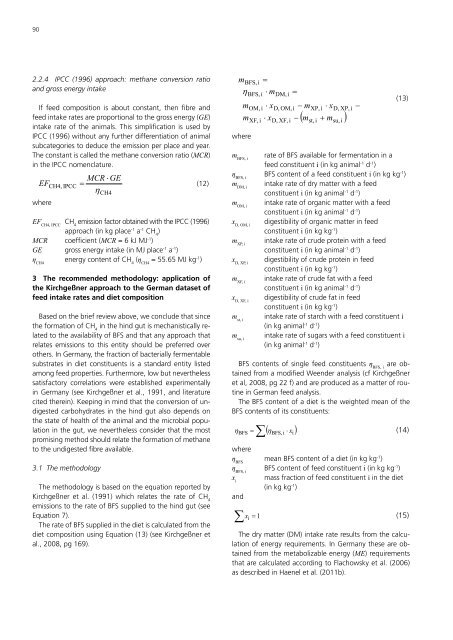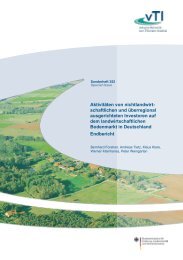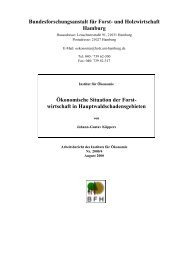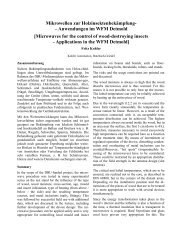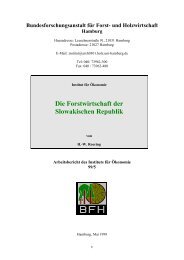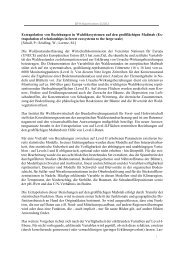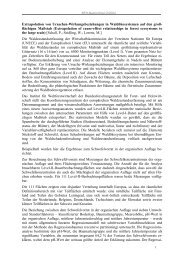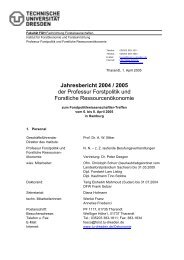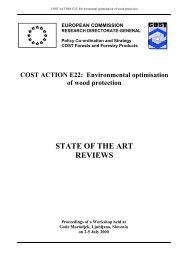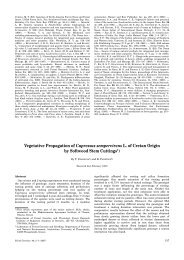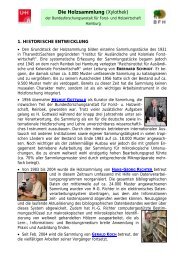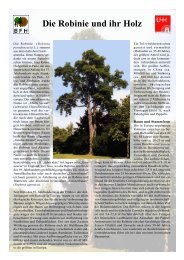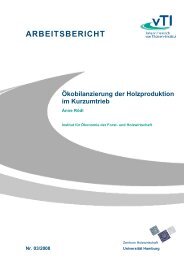Landbauforschung vTI Agriculture and Forestry ... - 1. Januar 2008
Landbauforschung vTI Agriculture and Forestry ... - 1. Januar 2008
Landbauforschung vTI Agriculture and Forestry ... - 1. Januar 2008
Create successful ePaper yourself
Turn your PDF publications into a flip-book with our unique Google optimized e-Paper software.
90<br />
2.2.4 IPCC (1996) approach: methane conversion ratio<br />
<strong>and</strong> gross energy intake<br />
If feed composition is about constant, then fibre <strong>and</strong><br />
feed intake rates are proportional to the gross energy (GE)<br />
intake rate of the animals. This simplification is used by<br />
IPCC (1996) without any further differentiation of animal<br />
subcategories to deduce the emission per place <strong>and</strong> year.<br />
The constant is called the methane conversion ratio (MCR)<br />
in the IPCC nomenclature.<br />
MCR ⋅ GE<br />
EFCH4,<br />
IPCC � (12)<br />
ηCH4<br />
where<br />
EF CH4, IPCC CH 4 emission factor obtained with the IPCC (1996)<br />
approach (in kg place -1 a -1 CH 4 )<br />
MCR coefficient (MCR = 6 kJ MJ -1 )<br />
GE gross energy intake (in MJ place -1 a -1 )<br />
η CH4 energy content of CH 4 (η CH4 = 55.65 MJ kg -1 )<br />
3 The recommended methodology: application of<br />
the Kirchgeßner approach to the German dataset of<br />
feed intake rates <strong>and</strong> diet composition<br />
Based on the brief review above, we conclude that since<br />
the formation of CH 4 in the hind gut is mechanistically related<br />
to the availability of BFS <strong>and</strong> that any approach that<br />
relates emissions to this entity should be preferred over<br />
others. In Germany, the fraction of bacterially fermentable<br />
substrates in diet constituents is a st<strong>and</strong>ard entity listed<br />
among feed properties. Furthermore, low but nevertheless<br />
satisfactory correlations were established experimentally<br />
in Germany (see Kirchgeßner et al., 1991, <strong>and</strong> literature<br />
cited therein). Keeping in mind that the conversion of undigested<br />
carbohydrates in the hind gut also depends on<br />
the state of health of the animal <strong>and</strong> the microbial population<br />
in the gut, we nevertheless consider that the most<br />
promising method should relate the formation of methane<br />
to the undigested fibre available.<br />
3.1 The methodology<br />
The methodology is based on the equation reported by<br />
Kirchgeßner et al. (1991) which relates the rate of CH 4<br />
emissions to the rate of BFS supplied to the hind gut (see<br />
Equation 7).<br />
The rate of BFS supplied in the diet is calculated from the<br />
diet composition using Equation (13) (see Kirchgeßner et<br />
al., <strong>2008</strong>, pg 169).<br />
m<br />
η<br />
m<br />
m<br />
where<br />
BFS, i<br />
BFS, i<br />
OM, i<br />
XF, i<br />
�<br />
⋅ m<br />
⋅ x<br />
⋅ x<br />
DM, i<br />
D, OM, i<br />
D, XF, i<br />
�<br />
− m<br />
−<br />
XP, i<br />
�m � m �<br />
st, i<br />
⋅ x<br />
D, XP, i<br />
su, i<br />
−<br />
(13)<br />
mBFS, i rate of BFS available for fermentation in a<br />
feed constituent i (in kg animal-1 d-1 )<br />
ηBFS, i BFS content of a feed constituent i (in kg kg-1 )<br />
mDM, i intake rate of dry matter with a feed<br />
constituent i (in kg animal-1 d-1 )<br />
mOM, i intake rate of organic matter with a feed<br />
constituent i (in kg animal-1 d-1 )<br />
xD, OM, i digestibility of organic matter in feed<br />
constituent i (in kg kg-1 )<br />
mXP, i intake rate of crude protein with a feed<br />
constituent i (in kg animal-1 d-1 )<br />
xD, XP, i digestibility of crude protein in feed<br />
constituent i (in kg kg-1 )<br />
mXF, i intake rate of crude fat with a feed<br />
constituent i (in kg animal-1 d-1 )<br />
xD, XF, i digestibility of crude fat in feed<br />
constituent i (in kg kg-1 )<br />
mst, i intake rate of starch with a feed constituent i<br />
(in kg animal-1 d-1 )<br />
msu, i intake rate of sugars with a feed constituent i<br />
(in kg animal-1 d-1 )<br />
BFS contents of single feed constituents η BFS, i are obtained<br />
from a modified Weender analysis (cf Kirchgeßner<br />
et al, <strong>2008</strong>, pg 22 f) <strong>and</strong> are produced as a matter of routine<br />
in German feed analysis.<br />
The BFS content of a diet is the weighted mean of the<br />
BFS contents of its constituents:<br />
∑<br />
�η ⋅ x �<br />
BFS � BFS, i i<br />
η (14)<br />
where<br />
ηBFS mean BFS content of a diet (in kg kg-1 )<br />
ηBFS, i<br />
BFS content of feed constituent i (in kg kg-1 xi )<br />
mass fraction of feed constituent i in the diet<br />
(in kg kg-1 <strong>and</strong><br />
)<br />
∑ x i � 1<br />
(15)<br />
The dry matter (DM) intake rate results from the calculation<br />
of energy requirements. In Germany these are obtained<br />
from the metabolizable energy (ME) requirements<br />
that are calculated according to Flachowsky et al. (2006)<br />
as described in Haenel et al. (2011b).


